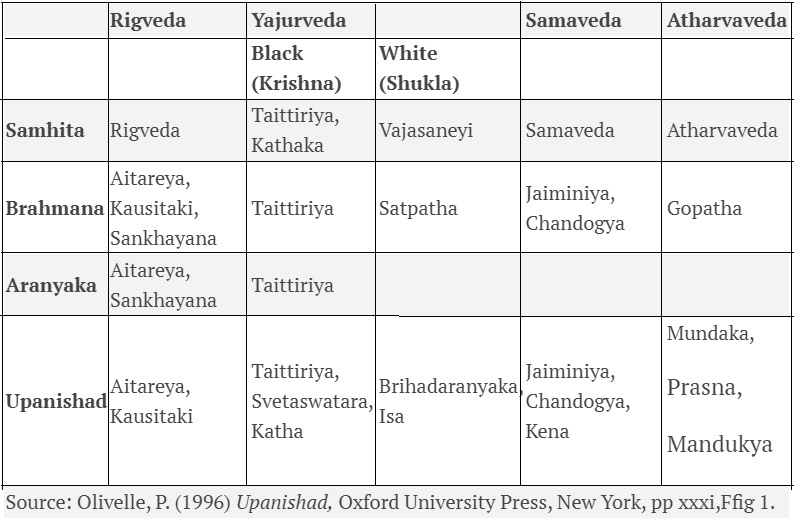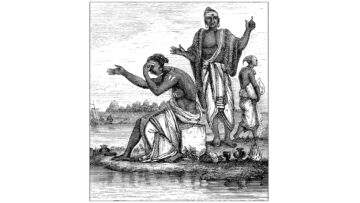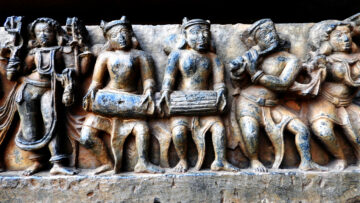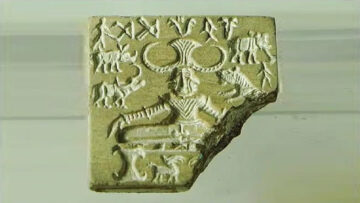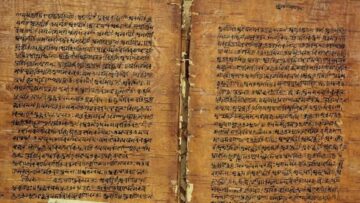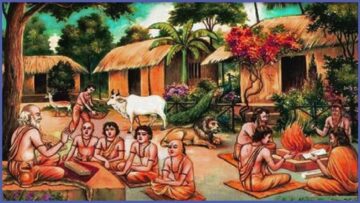The Rig Veda summarises the chief purpose of Vedic knowledge thus: ‘Assemble together, speak with one voice, let your minds be all of one accord…. Let all priests deliberate in a common way. Common be their assembly, common be their mind, so be their thoughts united…. United be the thoughts of all, that all may live happily, that ye may all happily reside” (Sharvanand, 2006: 198)[1].
‘In the world, there is no study so beautiful and so elevating as the Upanishads. It has been the solace of my life, and will be the solace of my death,” from the great nineteenth-century German philosopher Arthur Schopenhauer, paying homage to the sublime ideas that have been animating the Hindu tradition for almost three millennia’ (Idaho, n.d.)[2]
Abstract
The purpose of this paper is to provide further insights into the Vedas and the Upanishads (called Shrutis), that were referred to in the paper on the general framework of Hinduism, to develop our understanding of the core message of these texts. Such an understanding is crucial as the Shrutis provide the foundation for Hindu philosophical thought. Accordingly, this paper deals with the question: What is the central message of the Shrutis? How did the subsequent philosophical development take place using the thoughts from the Shrutis and what value do, if any, these thoughts have for the modern society? To answer these questions, many relevant sources were examined. I found that the central message of the Shrutis is that one must perform the duties ordained on her /him. Subsequent development of Hindu thought took place using the two main constructs offered by the Shrutis, that is, Jnana and Karma. Both these constructs are outstanding contribution of Hinduism to the world philosophy. The Shrutis encourage us to become better specimen of human beings for own good and for the good of the society.
-
Introduction
Though the Upanishads are a part of the Vedas, I present these separately. Upanishads are the place where one finds the full-fledged Hindu philosophy developed.
The Vedas
The Vedas (or knowledge) are the earliest available record of the Hindus. According to Bal Gangadhar Tilak – known as the ‘Father of Indian Unrest’ – the Vedas date back to 4,000 BCE but Max Muller, considers their age to be 1,200 BCE (Dasgupta, 1922)[3]. Max Muller (1899: 46) notes ‘Whatever may be the date of Vedic hymns, whether 1500 or 15000 BC they have their own unique place and stand by themselves in the literature of the world’. Accordingly, all the branches of Hindu philosophy, when considered in parts such as the metaphysics, ethics, epistemology and logic, owe their origin to the Vedas and use them as their source material. The Vedas are called apaurusheya, that is, not man-made but present eternally. They are the thoughts heard (Shruti) by spiritual scientists called Rishis in deep meditation during the quest of the Self. ‘The Vedas are described as apaurusheya, that is, written by no man. They were transmitted down from one generation to the next [by oral tradition] without anyone having a clue as to who wrote them’ (Narlikar, 2011: n.d.).[4]
There are four Vedic texts: Rigveda, Yajurveda, Samaveda and Atharvaveda. The Rig Veda Samhita is considered as the oldest of the four Veda. It has 1028 hymns in 10,500 verses approx. grouped in 10 chapters (mandalas). The Yajurveda Samhita is mainly prose work and is about two-third of the size of Rig Veda while the Sama and the Atharva Veda are each half the size of Rig Veda. Sama Veda borrows considerably from the Rig Veda while the Atharva Veda has no connection with sacrifices and instead addresses issues such as how to drive away diseases or how to ensure domestic harmony. It has 20 chapters or books and draws about one-fifth of Rig Veda (Raja, 2006)[5]. The other Vedas refer to the Rig Veda Samhita quite often and draw on it heavily. Vedic mantras (aphorisms) are used right from conception till the death rituals. Each of these texts are further divided in four parts. The ‘Samhita’ or a collection of verses, and the ‘Brahmana’ or the prose that explains the meaning of the verses. One section of the Brahmanas was called the Aranyakas and the other the Upanishads. Both deal with the esoteric portion of the Brahmanas. ‘Cosmological and metaphysical topics generally occupy a more central position in the Upanishad’ (Oliville, 1996: xxxii)[6]. The ritualistic part of the Samhita and Brahmana are called karma kand, the Aranyakas as upasana kand, or the meditational part, while the Upanishads are called as Jnana kand or the portion dealing with supreme knowledge. To understand the Vedas, Vedanga texts were created consisting of phonetics (siksa), rituals (kalpa), grammer (vyakarana), etymology (nirukta), metre (chhandas) and astronomy (jyotisha).
Oliville (1996) provides a schema of the Vedic corpus as below:
The word Upanishad literally means ‘sit down near’ the teacher. There are more than 200 Upanishads[7]. Dasgupta (1922)[8] provides a list of 112 Upanishads that are published. ‘The principal Upanishads are said to be ten. Samkara [Adi Shankaracharya] commented on eleven. Isa, Ken, Katha, Prasna, Mundaka, Mandukya, Taiattiriya, Aitareya, Chandogya, Brihad-aranyaka and Svetaswatara’ (Radhakrishnan, 1992:21)[9]. I provide a gist of the first 10 of these below. The other Upanishads to which Shankara refers to in his commentary on Brahma sutra, include Kausitaki, Jabala, Mahanarayana, and Paingala. Radhakrishnan (1992)[10] also includes Maitri Upanishad in this list and refers to these 15 as the principal Upanishads.
The Upanishads were composed since about 1,000 BCE to 1,400 CE (Olivelle, n.d.)[11]. They were passed on from one generation to the other by oral tradition. Several groups of students byhearted say Kena Upanishad and passed it on. Similar was the case with other texts. To facilitate such oral tradition, Sanskrit language was the best as it enabled conveying of meaning in a compressed form – in a few verses. Though the authorship of the Upanishad is unknown some prominent sages associated with the Upanishads include Aruni, Yajnavalkya and Svetketu.
According to Olivelle (1996)[12], geographically, the Upanishads were compiled in North India in the region from the foothills of Himalaya to the Vindhya Mountain towards the South and from the upper Indus valley (west) to the lower Ganges (east) – mainly the states of Uttar Pradesh and Bihar.
After a general introduction of the Vedas and Upanishads, I now move to the contents thereof in section 2, thereafter in section 3, I consider the relevance of these texts for modern society and section 4 concludes.
-
The Vedas and Upanishads (Shruti) : an overview
Hindu philosophy relies heavily on Sabdapramana (scriptural testimony) and even when it invokes other epistemological methods such as perception (pratyaksha) and inference (anumana) it defers to the Vedas (Adluri, 2014)[13]. Consequently, a study of the Shrutis becomes necessary to understand the platform on which the Hindu philosophical edifice has been built.
- The metaphysical and theological ideas in the Vedas
The Veda provide two different perspectives for examining the Ultimate Reality: the phenomenal (everyday experience perceptible by the senses) and the transcendental (abstract or beyond sense perception). ‘In the Vedas, the reality experienced at the transcendental level is called the Brahman’ (Nikhilanand, 2008:29)[14]. As per the Advait (non-dual) Vedanta strand of Hindu philosophy, the same Brahman when considered from the phenomenal perspective is called the Atman. At the level of Brahman, the same reality is experienced as unity (non-diverse, pure, universal consciousness). At the level of Atman, (individual consciousness), however, the diversity or difference is witnessed, and the worldly appearances become the reality. The Atman is conditional (conditioned, limited) while the Brahman is unconditional (unlimited). The unlimited Brahman is called sat-chit-anand (existence, knowledge and bliss). But how does the unlimited, unconditional Brahman become limited and conditional? Bernard (1947)[15]notes that the weight of the yarn, on the spindle or in the rug woven from it, doesn’t change but what changes is merely the form (roopa) and the name (naam). Accordingly, the Vedic literature asserts that the unlimited doesn’t disappear but gets a form and label when encased in a body. ‘The conditioned Brahman is called Ishwara (Nikhilanand, 2008)[16]. A realised soul attains the knowledge of the Atman and consequently sees unity everywhere at that level. When such a knowledge is absent (i.e. there is ignorance), one sees diversity and duality around. The central message of the Vedas is to focus on the Atman. To facilitate the realisation of the Atman, several meditational and Yoga practices have been suggested.
The Vedas occupy a central place in the life of a Hindu. The Mimansaka school holds the view that the purpose of Veda is to denote some karma or rite. However, another school holds the view that the main purpose of Vedas is two-fold, namely, ‘the attainment of mundane welfare including heavenly enjoyments (abhyudaya) and the realisation of the supreme spiritual beatitude (nihsreyasa)’ (Sharvanand, 2006:185)[17]. The purpose of karma and upasana kand is to attain the first objective while that of the jnana kand is the later objective or the search for the transcended or the Ultimate Reality.
Aditi – the ‘Big Bang’ moment in the Veda
The pre-Vedic deities – Sun, Earth, Sky, Rain and Fire – were subsumed by the Infinite called Aditi or the mother of gods according to the Rig Veda. Max Muller notes ‘Aditi, an ancient god or goddess, is in reality the earliest name invented to express the Infinite; not the Infinite as the result of a long process of abstract reasoning, but the visible Infinite, visible by the naked eye, the endless expanse, beyond the earth, beyond the clouds, beyond the sky’ (Max Muller, 1869:230)[18]. Aditi – the indivisible, unbroken, infinite, immanent Principal – was really the Big Bang moment of Sanatan Dharma contributed by the Vedic bards. The Rig Ved proclaims that ‘Aditi is the celestial sphere, Aditi is the intermediary space, Aditi is the mother, the father, the son, Aditi is all Gods, the five classes of beings, the created and again the cause of creation’ (Sharvanand, 2006:187)[19].
The concept of three planes or spheres and their respective deities
Another major contribution of the Rig Veda seers was the conception of three planes of the universe: dyuloka (uppermost or celestial plane), antarikshaloka (intermediary space) and the Bhurloka (terrestrial sphere). These spheres had three presiding deities, the Surya or Sun, Indra or Vayu and Agni or Fire respectively. Each of the deities had eleven sub deities in each sphere totalling thirty-three in total. According to Satapatha Brahmana there are eight Vasus, eleven Rudra, twelve Adityas and Dyu (sky) and Earth. Max Muller (1892)[20] notes that similar multiplicity of Gods is to be found in Greece and Rome but the polytheism in Hindu gods he describes as henotheism which refers to worship of one god but does not deny that there could be other gods. This is different from monotheism which asserts that there is one and only God and none other. Judaism, Christianity and Islam believe in monotheism, yet conflicts abound between them and of them with other religions (Almond, 2017)[21].
The gods of the celestial sphere are Mitra (god of light) and Varuna (god of sky). They are followed by Savitra or Surya – the giver of life, energy and wealth, and Vishnu – considered as the guardian of all and the founder of Dharma. Max Muller (1869) notes that Vishnu signifies the rising, culmination and the setting of the Sun. Vishnu is the immanent and all-pervasive Principle. Accordingly, the all-pervasive nature got recognised in Rig Vedic time itself. Indra is the most important god of Rig Veda. His associate is Marut – the wind god and Indra are credited with killing a demon and facilitate fall of rain to renovate life on earth. Vayu is the prominent god of the intermediary (etherial) space while Agni (fire) is the god of the terrestrial sphere.
All these deities are but the manifestations of One god (Raja, 2006)[22]
Hiranyagarbha (Vishwakarma)
In their metaphysical pursuits, the Rishi (seers), considered that the cosmic Principle, manifested as Hiranyagarbha as the efficient cause of the universe. The Rig Veda asserts that the Hiranyagarbha arose from the water. The much later Greek conception of the creation of the universe is similar. The pre-creation situation was described by them as ‘chaos’. Similar was the conception of the Egyptians. Accordingly, it was not a new beginning but rearrangement of things (Chowdhuri, 2008)[23]. Sharvanand (2006:194) [24]‘He who is the father of us all, the procreator, the great Providence. He who knows the whole universe. He is one yet assumes different names of gods, about him all people of the world become desirous to know’.
Param Purusha, Jivatma and Maya
The Rig Veda seers used three different methods – theological, metaphysical and psychological – to unravel the mysteries of the universe (Sharvanand, 2006). By theological method they realised intuitively that their god of worship was the transcendental impersonal Principal that underpins the whole universe. They called the cosmic being as Parama Purusha. In the hymns of ‘Hiranyagarbha and Viswakarman, the sages contemplated theistic [belief in One god] origin of creation. The Purusha -sukta, on the other hand, promulgates the pantheistic [material world is the manifestation of the transcendental reality] view of creation’ (Sharvanand, 2006:195). The psychological approach to the ultimate problem taken by the Rig Veda involved reassuring the individual that the Atman is the very same Brahman and consequently indestructible. It asserts that the individual soul is deluded by the Maya. It must be noted here that at the transcendental level, there is only pure consciousness or Brahman or the Ultimate Reality, the Maya arises at the phenomenal level because of the ignorance about our true original nature.
Yajna
Yajna represent the ritualistic part of the Vedic tradition. It is representative of the ‘entire cosmic process as the performance of a great sacrifice and believed that man’s spiritual nature can best be quickened if he tries to mould himself in consonance with that cosmic order’ (Sharvanand, 2006: 198)[25]. During Yajna, oblations are given to Agni (holy Fire) as Agni is regarded as the messenger (doot) that carries messages to all other gods (Raja, 2006)[26]. Typically, when a yajna (holy fire worship) is performed, four priests sit on the four sides of the Yajna Kund (altar) and each priest recites mantras from each of the Vedas. These rituals are the karma-kanda (Sharvanand, 2006)[27].
The concept of life and after life
The Vedic people had a very positive attitude towards life and offered prayers to the God for a happy life of one hundred years and beyond. After death, it was believed that man goes to a higher world called the pitra-loka where the departed souls live. A prayer in Rig Veda puts this beautifully as below:
‘O, Pavamana, place me in the deathless undecaying world…. Make me immortal in that realm where dwells the King Vivaswana’s son… (Griffith, 1896:449)[28].
The concept of transmigration of the soul (samsara), is not explicitly mentioned in the Rig Veda but comes in later Upanishads but there is enough evidence to suggest that they knew about the transmigration of the soul (Raja, 2006)[29].
Rig Veda notes two paths which are taken by the soul: devayana and pitrayana. The former doesn’t involve any return while the latter does involve return to the physical world after enjoying the fruits of the good deeds of previous life.
The Karma and Jnana
The concepts Karma and Jnana first appear in the Rig Veda when the Veda explains the different outcomes that flow from these. “A careful study of Rig Veda shows that even in early times, Karma and Jnana, were recognised as two separate factors in the spiritual progress of man’ (Raja, 2006).[30] The Law of Karma is the single most important contribution of Hinduism to world philosophy. It provides the most logical explanation available so far, the problem of evil that has engaged attention of world scholars for many years. Berger (1967)[31], for example, asserts that the Karmasiddhanta of the Hindus is the most logical answer to the problem of divine-justice called theodicy (why good people suffer, and bad people enjoy). Harman (1976:287)[32] asserts ‘Unlike the Western theories…… the doctrine of rebirth is capable of meeting the major objections against which those Western attempts all failed’. The famous sociologist Max Weber (1947:359)[33] notes that Karma, ‘stands out by virtue of its consistency as well as by its extraordinary metaphysical achievements’. Kaufman’s (2005)[34] criticism of Karma theory, has been rebutted by Chadha and Trakakis (2007)[35].
The concept of God in the Vedas
The Rig Veda is in poetic form. The hymns are mostly about the praise of deities such as Indra, Varuna, Mitra, and Agni to seek their help and favour. The nature was subject to basic underlying law to regulate all beings and other objects of nature. Though one could construe the many gods as polytheism, only the Supreme God was extolled. Interestingly, one could choose the Supreme God so that other gods became less important. Max Muller calls this ‘henotheism’. The Rig Veda proclaims ‘ekam sat vipra bahudha vadanti’ One reality is called by the wise in different ways’ (Chatterjee and Datta, 1984:352)[36] which clearly points to monotheism – belief in one god, one supreme consciousness or Principal. The idea that ‘names may be many and different but they all denote the same God occurs in Viswakarma sukta too’ (Tatwamayanand,2005:40)[37]. The concept of unity of God is to be found in the Purusha sukta where an organic unity of the whole universe (unity of godhead) is contemplated. ‘An inquiry into the one impersonal, attribute-less, form-less Principal behind all concepts of God occurs in Hiranyagarba Sukta….Shatpatha Brahmana and also in the Aitareya Brahmana’ (Tattwamatanand, 2005:40)[38]. It is also to be found in the Ishavasya and Taitareya Upanishad that assert that whatever is there in this world is permeated by Ishwara.
According to the Hindu concept then, God (the absolute Principle) is not only the creator, ruler but importantly also the in-dweller of all. This is where the concept of God of Abrahamic religions and Hinduism differs significantly. For Hindus, God is impersonal Principle but for Abrahamic religions it is a Personal God. For Hindus, God is in-dweller of all -not so in them. Furthermore, God in Hinduism takes the avatara (descents) into both human and animal form, not so in the Abrahamic religions. God is also conceived as a woman Aditi, Parvati, Lakshmi, Saraswati etc. not so in Abrahamic religions where it is a male god. “Hinduism is not theo-centric, in the usual sense, i.e. not based on Extra-Cosmic-Creator-God like the other western religions…in Hinduism God is an Expression or Cosmic Manifestation of the Supreme Infinite Spiritual Reality (Brahman)…He is not a Being in Heaven (Mukyanand,2000:20)[39]. The Varuna sukta of Rig Veda involves complete surrender to God and became the main principle of Vaishnavism. Here ‘the renunciation is Brahma and Brahma is the Supreme’ ((Tattwamatanand, 2005:42)[40].
The multiplicity of deities was intended perhaps to highlight the different natural forces that influenced human beings, the Rig Veda which recognised Aditi as the immanent Principal, further clarified categorically that divinity is One. Rukmani (2016:79)[41] notes ‘the ground-breaking contribution to religious and spiritual thought in the Rig Veda is the idea that the Ultimate Existence or the Truth is One and can be described variously by wise people ‘ekam sat vipra bahudha vadanti’. The Hamsavati hymn of Rig Veda specifically indicates that the same Principle ‘shines in the sky, in water, in light, in mountains and in Truth’ (Sharvanand, 2006:194)[42]. Accordingly, the Rig Veda recognised over 4,500 BCE that a single Principal, a universal cosmic force manifests itself in multiple ways. ‘Some of the Hindu philosophical systems are flatly atheistic… and in others God is only an ‘impersonal cosmic principle’ (Cooper, 2003:14)[43]. The Vedanta strand of philosophy calls this cosmic Principal, Brahman, which is an all-pervasive Spirit. Similar thoughts were expressed by later Jewish and Christian religions. ‘What Judaism calls God, the Holy One whose spirit is in all of us, is called Brahman by the Hindus. Jesus Christ said, I am the life…… as life I exist in all beings…I and my father are one’ (Sarvagatanand, 2009:576)[44].
The Purusha sukta describes the Supreme consciousness with an allegory of a thousand-eyed and thousand-footed purusha. The lord of immortality who is wide spread. The animals as well as the four varnas are created out of this Purusha. ‘The Brahmin was his mouth, out of his two arms were made the kshyatriyas, his two thighs became the vaisyas and from his foot the sudras were born’ (Klostermaier, 2007:87)[45]. The Sukta considers ‘all existence-earth, heavens, planets, gods, living and non-living objects – is conceived here as the parts of one great person (Purusha) who pervades the world but also remains beyond it’ (Chatterjee and Datta, 1984:353) [46]. It is panentheism (all is in God) not pantheism (all is equal to God).
The Nasadiya Sukta further underlined the Vedic position of the Impersonal Absolute. The reality underlying it all can’t be described it says. The primal can’t be described. Roy Chowdhury (2008:308)[47] notes ‘the Vedic seers viewed creation not as a new beginning but as an arrangement and organisation of all that lay in chaos’. The Nasadiya sukta points to the Advaitic monism. ‘In this hymn all phenomena are traced to the one Principle which is beyond opposites like life and death, existence and non-existence, being and non-being, day and night… it is perhaps the most scientific description of the Ultimate Reality as well as the projection of the phenomenal world’ (Tatvamayanand, 2005:44)[48].
Yajur, Sama and Atharva Veda
‘The Yajur Veda and the Sama Veda are of little importance to a student of ancient Indian culture’ (Raja, 2006:209)[49]. An optimistic tone and material plenty at that time is apparent throughout. The Atharva veda, however, seems to project a gloomy picture and handles issues such as black magic, injury to one’s enemy and other aspects of the present life. The other three Vedas are more futuristic in their outlook. Yet the Atharva Veda contains much of the philosophical literature. ‘The three Vedas are not so intimately related to the problems of the Absolute as is the Atharva Veda’ (Raja, 2006:210)[50].
Notes
[1] ibid
[2] Idaho, (n.d) Upanishads Retrieved: http://www.webpages.uidaho.edu/~rfrey/PDF/116/116%20The%20Upanishads.pdf
[3] Dasgupta, S. (1922) A history of Indian philosophy, Cambridge University Press, Cambridge. UK.
[4] Naralikar, J. (2011) How Tilak dated the Vedas?Retrieved: https://bharatabharati.wordpress.com/2011/01/15/how-tilak-dated-the-vedas-jayant-v-narlikar/
[5] Raja, C.K. (2006) Vedic culture, in the Cultural Heritage of India vol. 1, The Ramakrishna Mission Institute of Culture, Kolkata.
[6] Olivelle, P. (1996) Upanishads, Oxford University Press, New York.
[7] Radhakrishnan, S. (1992) The Principal Upanishads, Humanity Books, New York.
[8] Dasgupta, S. (1922) op cit.
[9] Op. cit.
[10] Op. cit.
[11] Olivelle, P. (n.d) Upanishad, Retrieved: https://www.britannica.com/topic/Upanishad
[12] Olivelle, P. 1996. Ibid.
[13] Adluri, S. (2014) Sabdapramana as a theological category in Vedanta Desika’s Tattvamuktakalapa, The Journal of Hindu Studies, Oxford, 7, pp. 54-69.
[14] Nikhilanand, S. (2008) Hinduism, Sri Ramakrishna Math, Madras.
[15] Bernard, T. (1947) Hindu Philosophy, The Philosophical Library, New York.
[16] Op.cit.
[17] Op. cit.
[18] Max Muller, F. (1869) Rig Veda Samhita, Trubner & Co, London.
[19] Taittariya Samhita
[20] Max Muller, (1892) India: What it can teach us, Longmans, Green & Co, London. (Reprinted by Forgotten Books 2016). Lectures delivered at Cambridge University.
[21] Almond, P. (2017) In spite of their differences, Jews, Christians and Muslims worship the same God, Retrieved: https://theconversation.com/in-spite-of-their-differences-jews-christians-and-muslims-worship-the-same-god-83102
[22] Raja. CK. (2006) op cit
[23] Chowdhuri, R. (2008) Cosmological reflections in ancient Indian literature, Prabuddha Bharat, Adwait Asharam, Kolkata. vol 113 no. 5
[24] Sharvanand, S. (2006) op. cit.
[25] ibid
[26] Raja, CK. (2006) op.cit.
[27] Sharvanand, S. (2006) The Vedas and their religious teachings, The Cultural Heritage of India, The Ramakrishna Mission Institute of Culture, Kolkata.
[28] Griffith, G. (1896) The Hymns of Rig Veda, Griffith.PDF, Retrieved: http://www.sanskritweb.net/rigveda/griffith.pdf
[29] Raja, CK. (2006) op.cit.
[30] ibid
[31] Berger, P. (1967) The sacred canopy: Elements of a sociological theory of religion, Doubleday, New York.
[32] Herman, A. (1976) The problem of evil in Indian thought, Motilal Banarsidass, Delhi.
[33] Weber, Max (1947) Essays in sociology, translated by Gerth and Mills, K. Paul, Trench, Trubner, London.
[34] Kaufman, W. (2005) Karma, Rebirth and the Problem of Evil, Philosophy East and West, vol. 55, no. 1. pp. 15-32.
[35] Chadha, M. and N. Trakakis (2007) A response to Karma and the Problem of Evil: A response to Kaufman, Philosophy East and West, vol. 57, no. 4. pp. 533-556.
[36] Chatterjee, S. and Datta, D. (1984) An introduction to Indian philosophy, University of Calcutta. India
[37] Tatwamayanand, S. (2005) The concept of God in the Vedas, Prabhuddha Bharat, vol.110 no. 6. Advait Ashrama, Kolkata.
[38] Ibid
[39] Mukhyanand, S. (2000) Hinduism: the eternal dharma, Centre for Reshaping our world view, Calcutta.
[40] ibid
[41] Rukmani, T. (2016) Shakti, the supreme mother goddess in Hinduism, Prabuddha Bharat, Adwait Ashram, Kolkata, vol 121 (1), pp. 79-83.
[42] Sharvanand, S. (2006) ibid
[43] Cooper, D. (2003) World Philosophies: An historical introduction, Blackwell Publishing, USA.
[44] Sarvagatanand, S. (2009) Vedanta and the search for Truth, Prabuddha Bharat, Adwait Ashram, Kolkata. vol. 114, no 10.
[45] Klostermaier, K. (2007) A survey of Hinduism, State University of New York, New York.
[46] Chatterjee and Datta, 1984. op.cit.
[47] Roy Chowdhury, R. (2008) Cosmological reflections in the ancient Indian literature, Prabuddha Bharat, vol.113, no. 5, Advait Ashrama, Kolkata.
[48] Tatwamayanand, S. (2005) op cit
[49] ibid
[50] ibid
Featured Image Credit: Double Excelsior
(This article was published by IndiaFacts in 2018)
Disclaimer: The opinions expressed in this article belong to the author. Indic Today is neither responsible nor liable for the accuracy, completeness, suitability, or validity of any information in the article.


